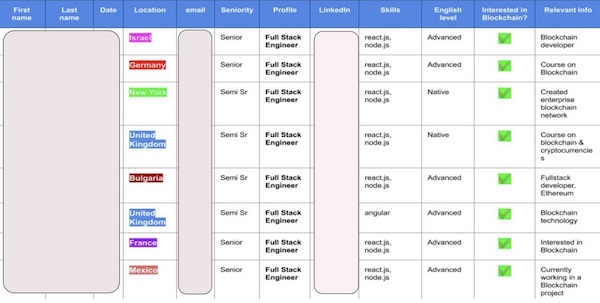TALENT PIPELINE SERVICES
How to Build a Talent Pipeline strategically
The hiring manager’s vision and needs must be based on the talent pipeline strategy in talent acquisition.
You lay the groundwork for effective sourcing by feeding this vision with a bigger image: the Candidate Persona.
ABOUT OUR PROCESS
Bondy Talent Pipeline
In such a fiercely competitive area as technology, talent pipeline management has become one of the pearls in personnel planning. Frontline firms are implementing innovative techniques to curate a ready-to-join talent pool because they can no longer afford the costs associated with delays in filling roles.
But If you go with but, then the comma should be deleted, building a talent pipeline takes far more than boolean search expertise and a list of potential candidates with relevant hard skills. The grounds for us to develop a hiring plan are the organization’s culture, employer brand, and business plan. In the long run, this will lead to resource profiling.
Here is an article that discusses the model we use to align with our client’s goals for a successful talent pipeline and sourcing.

A talent pipeline is defined as “a pool of qualified and assessed applicants eager to fill critical roles within a company.” This pool could contain promising internal personnel and external prospects found through referrals, web portals, tech and open source groups, and social media.
Our recruitment staff invests a significant amount of time and money into growing our talent pool. Given how effective it is to reduce hiring time, minimizing employee rotation, and ultimately ensuring our clients’ businesses run smoothly, this assignment is well worth the effort.
The foundations for building a talent pipeline
Building a talent pipeline is akin to any digital marketing approach in many respects. Clarity regarding the business goals, identifying our target audience, Buyer Persona profiling, nurturing and creating a relationship with potential consumers are all part of understanding who the best candidate is.
A Talent pipeline plan must inevitably begin with a workforce analysis and an in-depth understanding of the employer brand in the era of People-First and employee-centered organizations:
- Having a clear understanding of the company’s structure and culture.
- Supporting the company’s objectives.
- Identifying potential future shortages to forecast business talent requirements.
- Recognizing which essential and difficult-to-fill roles should be prioritized in our talent pipeline approach.
- Identifying internal advancement opportunities through profiling ideal people.
The goal of employing Candidate Persona is to get us ready to do a simple pipelining technique before moving on to sourcing. While it gives us a better grasp of our target audience, it also anticipates the challenges we might experience during the hiring process.
Pipelining candidates: sourcing
Depending on the results of our Persona research, talent sources for pipelining applicants may include:
- Using the most relevant keywords in Boolean searches on professional networks like LinkedIn.
- Using the correct search parameters, run X-ray or advanced queries in open code forums (Github, Stackoverflow, etc.). These platforms provide insight into the quality of the candidate’s code and their preferred technology stacks. Stars and badges, on the other hand, provide peer approval and acknowledgment.
- Identifying talent in local or global IT networks and groups discussing related topics (Twitter, Instagram, Facebook, DevCommunity, amongst others).
- Consulting universities’ databases. The NYC Tech Talent Pipeline is doing an excellent job in providing the technology industry with a robust talent pool from NYC institutions and boot camps. There are rising stars in this field, such as the NYC Tech Talent Pipeline. This free service platform gives you access to untapped tech talent previously vetted through a three-step screening process.
- Resorting to referrals from colleagues.
- Applying keyword filters to our applicant tracking system (ATS) database to find prospects with the biggest potential.
“What if” analysis to detect skills gap
The “What if” analysis, which is widely employed in contingency plans, is an intriguing exercise in role-playing different scenarios. We identify the jobs that would have a negative impact on the revenue if a vacancy occurred, and create multiple scenarios: What if this team member quit or was relocated to a different location? We can use this as a trigger to identify critical jobs and, therefore, assess critical abilities.
Whether you work in Human Resources or as a talent acquisition leader, it is crucial to regularly update these critical roles’ job descriptions as part of contingency or workforce planning and staff replacement. Simultaneously, changing job descriptions provides the necessary framework for rethinking the skillset and gaps in that specific role. This strategic approach is the cornerstone of our talent acquisition strategy.
The Candidate Persona profiling
Defining the Candidate Persona (CP) gives us a larger picture and defines soft skills or human attributes that would fit the organization’s culture if we agree on the updated job description and critical abilities of the strategic role to be pipelined.
A Candidate Persona is a collection of common characteristics that an ideal candidate would have. The goal of employing Candidate Persona is to understand our target audience better so that we can reach out to them.
We are exceedingly reluctant to use our own beliefs or assumptions as the basis for portraying the CP. Our research is based on real data. If other employees in your business perform similar tasks, having a chat can be highly beneficial in reducing biases.
Engaging in short calls with former applicants who do similar tasks can provide a wealth of information for a recruiter to consider before moving on to sourcing. The vast majority of recruiters that utilize Candidate Persona’s profile are interested in three things:
- Who is playing this part? According to employment needs, this field encompasses education, training, hard skills, and certifications.
- What are their primary concerns and interests? What are the factors that might encourage our CP to look for work? Are they on their way to a specific career or technology? In their personal lives, what do they value the most? What advantages would they find more appealing?
- What are the best ways and places for us to connect? What communities, conferences, and networks can we use to communicate with our CP? What are the greatest ways to reach out to people? How long do you think it would take to engage them? What kind of communication would be more appropriate and exciting?
OUR AIRTABLE FILE
Pipelined candidates delivery
As we come across prospects, we enter their information into an Airtable file, which compiles all the relevant information for subsequent analysis and outreach. When clients hire our sourcing service, we occasionally give the pipelined-candidates table to them. This delivery depends on the service our client has asked for.
Airtable strategies to deliver pipelined candidates
It is important to include all the fields your Applicant Tracking System will require when you upload the information, regardless of the type of table you use (Airtable, Google Sheets, or other tools). Date, full name, location, email, LinkedIn profile URL, Profile, Seniority level, and technical skills are the minimum fields to fill up (languages, frameworks, and other technologies), English level, key interests, and prior experience. We look at the candidates’ motivational features and soft skills during screening calls and interviews to find out if they are suitable for the client’s company.

CONCLUSION ABOUT TALENT PIPELINE SERVICES
The employer’s brand identity can help you determine what kind of talent might be a good fit for the company’s culture. At the same time, as you progress through the recruitment process, it provides valuable information on the communication style to use when addressing potential candidates.
About our talent pipelining service
What is a talent pipeline?
A talent pipeline is a system or process that companies use to identify, assess, and develop potential candidates for future job openings. The purpose of a talent pipeline is to have a pool of qualified candidates ready and available to fill open positions as they become available, instead of having to start from scratch each time a position needs to be filled.
Why is it important to have a talent pipeline?
There are a few reasons why it is important to have a talent pipeline:
- It helps to ensure that there are qualified candidates available to fill open positions as they become available.
- It can help to reduce the time and cost associated with recruiting new employees.
- It can help to improve employee retention rates, as talented individuals are more likely to stay with a company if they feel that there are opportunities for career advancement.
- It can help to build a positive reputation for your company, as potential candidates will view your company as being proactive and invested in their development.
How do you create a talent pipeline?
There are a few key steps to creating a talent pipeline:
- Identify the types of roles you anticipate needing to fill in the future.
- Develop criteria for each role.
- Find potential candidates using various methods such as recruiting agencies, social media, job boards, and colleges/universities.
- Assess candidates to determine if they meet the criteria for the role.
- Develop a relationship with talented candidates so they are aware of your company and interested in joining it in the future.
What is the difference between talent pool and talent pipeline?
The difference between a talent pool and a talent pipeline is that the first one is a group of potential candidates who may be qualified for a position, whereas a talent pipeline is a system or process that companies use to identify, assess, and develop potential candidates for future job openings.